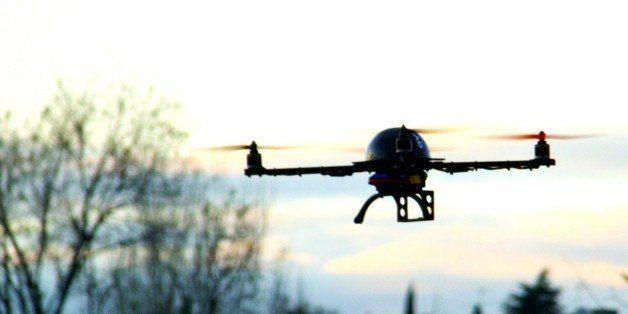
The Federal Aviation Administration recently released a report detailing more than 190 safety incidents involving drones and commercial aircraft. In response, Senator Dianne Feinstein (D-Calif.) has vowed to push legislation that would crack down on the commercial use of drones, also called Unmanned Aircraft Systems (UAS). India's Directorate General for Civil Aviation has already banned all use of drones in the country -- even for civilian purposes.
There are valid concerns that the proliferation of drones will endanger commercial flights and cause serious accidents. The U.S. military is rightfully worried that drones will be weaponized as killing machines and become autonomous flying IEDs (improvised explosive devices) that target a specific individual by means of facial recognition.
Banning commercial drone use will not solve these problems; it will just give us a false sense of comfort and kick the can further down the road.
About two years ago, I wrote a Washington Post column in which I argued that we need to prepare ourselves for the "drone age." It isn't just the United States that is developing drone capabilities; governments and DIYers all over the world are doing the same, particularly the Chinese. This isn't all bad; there are many good uses for drone technologies.
To start with, there isn't yet a clear consensus on what a drone is. Is it something that flies and is remote controlled? If that is the case, should the FAA also ban remote-controlled airplanes and helicopters that hobbyists have flown happily and relatively safely for many years? The drone encounter that Senator Feinstein cited in a Senate Commerce Committee hearing as a reason to regulate commercial drone flights was reportedlyjust a pink toy helicopter.
Then there is the practicability of enforcement. If the government should institute restrictions and penalties, who will enforce them? Will the police buy high-performance drones to shoot down illicit drones? Can we scramble the Air Force to blow a flock of $300 quadcopters out of the sky? Should we equip legions of young children with air rifles? Proposing laws without realistic hope of enforcement does nothing to solve the problems at hand.
Let's first acknowledge that drones will be common in our skies and that they will play an integral role in our economy and society. We know that drones are saving money and improving safety on many types of remote inspection such as that of distant pipelines and tall broadcast towers. Documentary filmmakers use drones to get aerial shots that are not affordable with a regular plane or helicopter. As well, start-ups like Matternet are pioneering the use of drones to deliver critical medical supplies to remote parts of the developing world. Drones could be used as long-haul cargo-delivery vehicles, allowing for more efficient point-to-point delivery of goods and materials. Then of course, companies such as Google and Amazon are developing drone delivery services that provide within-the-hour delivery of ordered goods--without putting any more traffic onto the streets or carbon into the skies.
So if we don't ban the drones, what can we do to prepare for them and weave their capabilities into a broader picture of economic development?
First, there needs to be a core technology framework for collision avoidance. This is no small problem. Even the best computer-vision algorithms struggle to navigate complex cityscapes. The vehicles in NASA's DARPA challenge weighed thousands of pounds and carried serious computational and sensor firepower. Yet they could barely navigate barren wastelands without flipping themselves over or running into a wall. So how will a drone the size of a shoebox carry enough intelligence to avoid hitting a building, a person, a car, a power line or, worst case, a commercial aircraft? It's a wonderful engineering challenge and worth the focus of some of our best minds.
Assuming we have collision-avoidance systems in place, how can we build a system of distributed air-traffic control for drones? It would obviously need to be computer-driven and automatic, and to include safety measures and emergency kill switches or other mechanisms to bring down a drone that is malfunctioning or poses a danger. We would need to plan for specific air corridors in city areas that are dedicated to drones and confine the drones to those places. Again, this is a huge engineering challenge, but not one that is insurmountable.
We also need to build private and commercial air-defense systems, just as the military is developing, to shield our schools, homes, and businesses from drone surveillance or attack. I wonder whether force fields such as we saw on Star Trek may become a practical reality.
Beyond the technical issues, we need to debate what is socially acceptable and to create legal frameworks. Should the cameras of delivery drones be recording and saving all video footage as they enter into the airspace of a customer's home? For that matter, should drones be allowed to fly over private property at all -- or should they be limited to public roads between droneports? Should we have the right to shoot down unauthorized drones on our property? If the Second Amendment grants the right of gun ownership to individuals for self-defense, then does it allow them to fly their own defensive drones?
These are issues we need to tackle -- and soon. The drones are coming, whether we are ready or not.
Vivek Wadhwa is a fellow at Rock Center for Corporate Governance at Stanford University, director of research at Center for Entrepreneurship and Research Commercialization at Duke, and distinguished fellow at Singularity University. His past appointments include Harvard Law School, University of California Berkeley, and Emory University.
